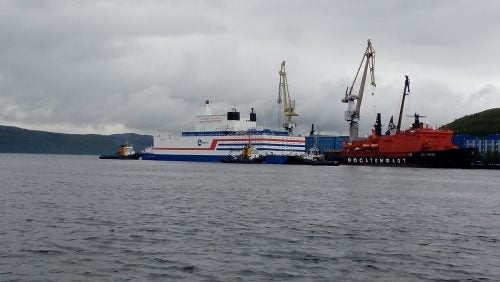Floating Nuclear Reactors and Russia’s Territorial Claims in Arctic Waters
April 22, 2021 by Digital Editor

The Akademik Lomonosov, Russia's first floating nuclear power station, docked to the harbor of Arctic port town Pevek.
By David Roghair
Despite a lull following the breakup of the Soviet Union, Russia has rapidly expanded its civilian nuclear power capability in recent years. A fleet of nuclear-powered icebreakers keeps shipping lanes open along the Northern Sea Route, and more icebreakers are in production. In December 2019, ROSATOM, the Russian state-owned nuclear energy enterprise, placed the world’s first floating nuclear power plant, the Akademik Lomonosov, in the port of Pevek in the Chukotka region on the eastern Siberian coast. This floating plant has the capacity to provide electricity for a population of 100,000. In February 2021, Rosatom announced plans for five more floating nuclear power plants in the same region. A territorial dispute, however, could prevent any meaningful environmental regulation of this “flotilla” of reactors.
These waters fall within the Northern Sea Route, an area that has seen increased shipping traffic with the melting sea ice in the Arctic Ocean due to climate change. In fact, after the Ever Given container ship obstructed traffic (and global trade) in the Suez Canal for several days in March 2021, the Russian government began billing the NSR as a safer alternative, offering subsidies to make the expensive journey more cost-effective for shippers. Russia disputes the designation of the NSR as “international waters” under the United Nations Convention on the Law of the Sea (UNCLOS). Under UNCLOS Article 86, all seas that are not “in the exclusive economic zone, in the territorial sea or in the internal waters of a State” are considered “high seas,” upon which all states have freedom of navigation under Article 87. Russia, however, claims special sovereignty over all waters to its north, extending beyond the North Pole, based on its surveys of undersea ridges starting within its exclusive economic zone and covering the territory at issue. Article 77 of UNCLOS gives a state special sovereignty over its continental shelf “for the purpose of exploring it and exploiting its natural resources.” The United Nations Commission on the Limits of the Continental Shelf (CLCS) has yet to recognize Russia’s claim, and both Denmark and Canada have competing claims to some of the territory at issue. Nevertheless, Russia considers the NSR to be its own internal waters rather than high seas subject to freedom of navigation under UNCLOS.
The International Atomic Energy Agency (IAEA), whose membership includes Russia, the United States, and 170 other countries, first published its Regulations for the Safe Transport of Radioactive Materials in 1961, with the most recent update in 2018. While Russia’s laws on nuclear energy incorporate IAEA standards, along with the numerous nuclear treaties to which it is a party, and while Russia has strong environmental laws on the books, its enforcement efforts continually fall short. There is both a lack of capacity and a lack of interest in enforcing environmental laws: multiple bureaucratic reorganizations in recent years have hampered institutional capabilities, while the Putin administration has engaged in active suppression of environmental advocacy from citizens and nongovernmental organizations.
As a coastal state, Russia has a responsibility under UNCLOS to “protect and preserve the marine environment,” including the waters within its exclusive economic zone near the coastline. UNCLOS, however, does not go beyond this vague proclamation, and leaves the details for individual states to decide. Waters near the coastline are the most intensely utilized areas. Concerns over the danger of nuclear materials in the Arctic is not new: revelations in the 1990s of Soviet submarines dumping reactors, fuel assemblies, and other radioactive matter into the Arctic and North Pacific Oceans caused alarm for residents of Alaska and the Pacific Northwest, and other adjacent countries. The impact on Alaska Native communities, who depend on the ocean for food supplies, was of special concern. In the Kara Sea, adjoining northwest Russia, there are known to be “17,000 containers and 19 vessels with radioactive waste, 14 nuclear reactors, and low-level liquid waste which was poured directly into the sea by the Soviet military” as well as the K-27 nuclear submarine, sunk in 1981.
The opening of the NSR could have a lasting effect on global shipping, and a flotilla of floating nuclear reactors could supply the people (and industry) of Russia’s northern regions with cheap electricity for many years. With Russia’s lax attitude toward environmental protection, however, these reactors could not only endanger the health and well-being of the local population, but could also have farther-reaching effects, with Alaska less than 600 miles away.
David L Roghair is an LLM student at Georgetown, and a Magistrate Judge for the Alaska Court System in his hometown of Utqiaġvik (Barrow), on the Arctic Ocean. The views and opinions expressed in this blog post are those of the author and do not necessarily reflect those of his employer. This post contains material prepared for the course Legal and Regulatory Issues in International Energy and Extractive Industries, Professor Leonardo Sempertegui, Georgetown University Law Center, Spring 2021.

